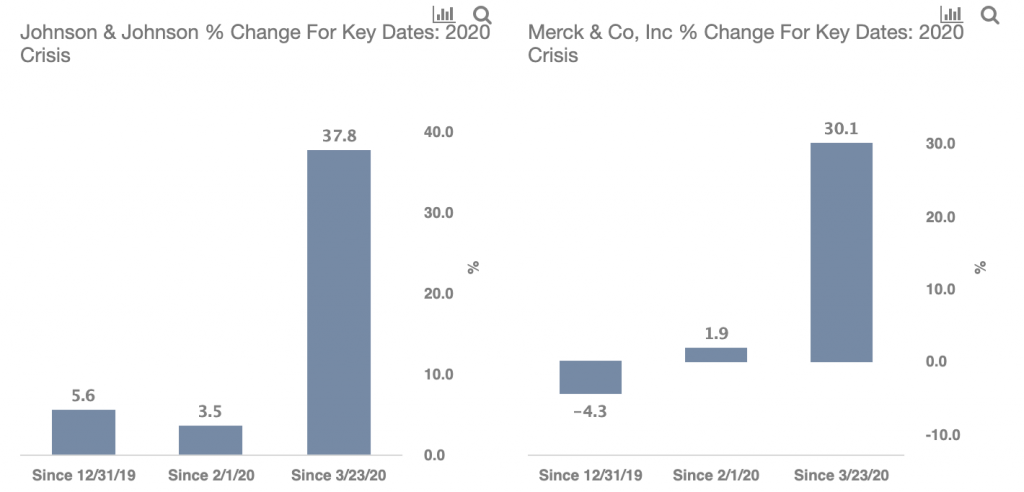Consider Buying Merck Over Johnson & Johnson’s Stock
Johnson & Johnson’s stock (NYSE:JNJ) has gained 38% since the March 23 lows of this year, while Merck’s stock (NYSE:MRK) has slightly underperformed and gained 30% of its value. The lockdown in various parts of the world has had a negative impact on the pharmaceuticals industry worldwide due to deferment of elective surgeries and fewer hospital visits. However, we believe Merck will likely fare better than Johnson & Johnson because of its valuation, restructuring initiatives, and expansion of Keytruda. Specifically, Merck plans to spin-off its low-growth women’s health and older drugs portfolio and focus on high-growth products. Keytruda, in particular, remains the biggest drug for Merck with sales of over $11 billion (roughly a quarter of total revenues) in 2019, and it will likely continue to gain market share. These initiatives will likely aid Merck’s revenues as well as margins over the coming years.
Our conclusion is based on our detailed dashboard analysis, ‘Merck Could Offer More Upside Compared To Johnson & Johnson‘, wherein we compare trends in key metrics for the two pharmaceutical giants over the years to determine their relative valuations under the current circumstances. We summarize parts of this analysis below.
Why Has Johnson & Johnson Outperformed Merck Over Recent Weeks?
- What’s Next For Johnson & Johnson Stock After Beating Q1 Earnings?
- Here’s What To Expect From Johnson & Johnson’s Q1
- What’s Next For Johnson & Johnson Stock After A 6% Decline In A Month?
- Is Johnson & Johnson Stock A Better Pick Over AbbVie?
- Will Johnson & Johnson Stock Rebound To Its Pre-Inflation Shock Highs of $185?
- Should You Pick Johnson & Johnson Stock At $160?
Johnson & Johnson’s P/E multiple based on 2019 earnings has increased slightly from around 16.6x at the end of 2019 to 17.5x currently, while Merck’s multiple has decreased from 17.4x to about 16.5x. The gains in Johnson & Johnson’s multiple can partly be attributed to its Covid-19 vaccine, which is currently in late stage of development, and it will likely bolster sales growth for Johnson & Johnson over the coming years. The company could have a leg up over rivals in terms of production capacity and distribution reach and has indicated that it aims to supply over one billion doses globally through the course of 2021 if the vaccine proves safe and effective.
Looking at Merck, it has a lot of positives to look forward to. To begin with, Keytruda continues to see massive growth with market share gains, and this trend is expected to continue. In fact, we consider an outlier scenario of Keytruda topping $30 billion in sales, and the drug alone to be worth $200 billion, compared to total Merck’s market cap of $217 billion currently. Beyond Keytruda, the company earlier this year announced its plans to separate its Women’s Health business, and focus on its high growth businesses. This will likely bolster Merck’s Non-GAAP Net Margins, which stood at 29% in 2019, slightly higher than the 28% figure for Johnson & Johnson.
While for both Johnson & Johnson and Merck, the P/E multiple looks attractive, we believe Merck could see better growth in the near term. Johnson & Johnson sales are at a higher risk in the near term, given the deferment of elective surgeries and its impact on the company’s Medical Devices business. Johnson & Johnson reported a 34% decline in Medical Devices sales in Q2 2020. Notably, Merck’s P/E is lower than the levels seen in 2018 and 2019. On the other hand, Johnson & Johnson’s P/E though it looks attractive, is 15% higher than the level seen at the end of 2018. This leads us to believe that Johnson & Johnson stock could see slower growth compared to Merck.
But How Long Before The Economy Recovers And Merck Stock Gains?
- The expected timeline for recovery in global economic conditions, and further rally in Merck’s stock, hinge on the broader containment of the coronavirus spread. Our dashboard forecasting US Covid-19 cases with cross-country comparisons analyzes expected recovery time-frames and possible spread of the virus.
- Further, our dashboard -28% Coronavirus crash vs. 4 Historic crashes builds a complete macro picture and complements our analyses of the coronavirus outbreak’s impact on a diverse set of Merck’s multinational peers, including Pfizer and Roche. The complete set of coronavirus impact and timing analyses is available here.
- There are signs of recovery in demand for most sectors already in Q3, with gradual lifting of lockdowns and a gradual rise in number of Covid-19 cases remaining within the manageable capacity of hospitals and care providers. In fact, elective surgeries which were deferred earlier in Q2 are now being attended to, and this should bode well for pharmaceutical companies at large.
- Although most companies will report poor full year 2020 results, market expectations will be buoyed by a visible improvement in the situation on the ground.
Overall, we believe Merck’s stock price at levels of $85 provides a buying opportunity for investors willing to be patient.
See all Trefis Price Estimates and Download Trefis Data here
What’s behind Trefis? See How It’s Powering New Collaboration and What-Ifs For CFOs and Finance Teams | Product, R&D, and Marketing Teams

